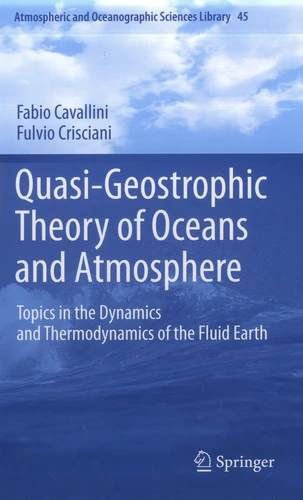Quasi-Geostrophic Theory of Oceans and Atmosphere. Topics in the Dynamics and Thermodynamics of the Fluid Earth
Par : ,Formats :
- Paiement en ligne :
- Livraison à domicile ou en point Mondial Relay indisponible
- Retrait Click and Collect en magasin gratuit
- Nombre de pages385
- PrésentationRelié
- FormatGrand Format
- Poids0.75 kg
- Dimensions16,0 cm × 24,2 cm × 2,8 cm
- ISBN978-94-007-4690-9
- EAN9789400746909
- Date de parution01/01/2013
- CollectionAtmospheric and Oceanographic
- ÉditeurSpringer
Résumé
Large scale flows are strong movements in the atmosphere and in the oceans, governed by the balance between Coriolis and pressure gradient forces (geostrophic equilibrium). This book describes the dynamics, mechanics and thermodynamics of these winds and currents. It is written for researchers, but also accessible for students in the field, since it also gives an overview of applied quasi-geostrophic theory suitable to advanced undergraduate and beginning graduate courses.
Chapter 1 presents concepts and equations of classical inertial fluid mechanics. Chapter 2 deals with the equations of thermodynamics that close the governing equations of the fluids. Then, the motion is reformulated in a uniformly rotating reference frame. Chapter 3 deals with the shallow-water model and the homogeneous model of wind-driven circulation. The chapter also describes a classical application of the Ekman layer to the atmosphere.
Chapter 4 considers the two-layer model, as an introduction to barochnic flows, together with the concept of available potential energy. Chapter 5 takes into account continuously stratified flows in the ocean and in the atmosphere.
Chapter 1 presents concepts and equations of classical inertial fluid mechanics. Chapter 2 deals with the equations of thermodynamics that close the governing equations of the fluids. Then, the motion is reformulated in a uniformly rotating reference frame. Chapter 3 deals with the shallow-water model and the homogeneous model of wind-driven circulation. The chapter also describes a classical application of the Ekman layer to the atmosphere.
Chapter 4 considers the two-layer model, as an introduction to barochnic flows, together with the concept of available potential energy. Chapter 5 takes into account continuously stratified flows in the ocean and in the atmosphere.
Large scale flows are strong movements in the atmosphere and in the oceans, governed by the balance between Coriolis and pressure gradient forces (geostrophic equilibrium). This book describes the dynamics, mechanics and thermodynamics of these winds and currents. It is written for researchers, but also accessible for students in the field, since it also gives an overview of applied quasi-geostrophic theory suitable to advanced undergraduate and beginning graduate courses.
Chapter 1 presents concepts and equations of classical inertial fluid mechanics. Chapter 2 deals with the equations of thermodynamics that close the governing equations of the fluids. Then, the motion is reformulated in a uniformly rotating reference frame. Chapter 3 deals with the shallow-water model and the homogeneous model of wind-driven circulation. The chapter also describes a classical application of the Ekman layer to the atmosphere.
Chapter 4 considers the two-layer model, as an introduction to barochnic flows, together with the concept of available potential energy. Chapter 5 takes into account continuously stratified flows in the ocean and in the atmosphere.
Chapter 1 presents concepts and equations of classical inertial fluid mechanics. Chapter 2 deals with the equations of thermodynamics that close the governing equations of the fluids. Then, the motion is reformulated in a uniformly rotating reference frame. Chapter 3 deals with the shallow-water model and the homogeneous model of wind-driven circulation. The chapter also describes a classical application of the Ekman layer to the atmosphere.
Chapter 4 considers the two-layer model, as an introduction to barochnic flows, together with the concept of available potential energy. Chapter 5 takes into account continuously stratified flows in the ocean and in the atmosphere.


